Sound and display settings on an Android smartphone
In the modern world, a smartphone is an integral part of the life of almost every person, which allows you to always be in touch. Sometimes it is just necessary, but there is another side to the coin. Phone calls, SMS messages, notifications from various applications can come at any time and sometimes it is inappropriate. In order to regulate all alerts on Android there is a special function - the "Do not disturb" mode. In this article, you will learn how to enable or disable Do Not Disturb on your device.
What is the "Do not disturb" mode on Android?
Silent mode has been around for a long time, but it is not always appropriate, as you can not hear and miss an important call or message. That is why at the end of 2014, after new version operating system Android 5.0 Lollipop, a new feature appeared in smartphones - “Do not disturb” mode.
The Do Not Disturb feature gives the user the ability to personally tweak and choose who can disturb him and when. This mode is very convenient and extremely flexible implemented.
With it you can:
- receive messages and calls only from selected subscribers
- mute at night or during important tasks
- turn off all the signals on the device, except for the pre-set morning alarm, and much more
In the settings of the "Do Not Disturb" mode, you can set priority calls and alerts, or set the mode to complete silence based on your needs.
How to enable the "Do not disturb" mode on Android
To activate this feature does not need any related applications. Everything is configured in the settings of the gadget.
For this you need:
- enter the settings menu
- after open the section "Sound" and "Notifications"
- go to the item "Do not disturb"
- drag slider to "On"
How to set up the Do Not Disturb mode on Android
In the settings you can completely turn off the sound, leave only an alarm clock, or set up exceptions for important calls only. There are three options in the Do Not Disturb mode:
- complete silence. In this variant, when receiving SMS messages, calls and notifications, sound signals and vibration do not work. Music, including in applications and video does not play. Alarm clock does not work either
- only alarm. All sounds, except for the alarm, are inactive.
- only important. You will hear only your selected priority calls, SMS messages and notifications. All other alerts will be silent.
You can also set up rules in the Do Not Disturb mode. One of them may be silent mode at the certain time. This is very convenient if you are busy every day with something important or, for example, you want to spend your lunch break in absolute silence and not be distracted by calls and messages. You can specify either one rule or a series of rules.
For this you need:
- go to the "Settings" gadget
- hereinafter "Sound" and "Notifications"
- do not disturb mode
- after the "Rules"
- and "Add rule"
- specify your rule (for example, "Lunch") and be sure to apply the time frame
- then confirm your actions
Many are annoyed when an important meeting or meeting is distracted by messages or calls. This nuance is also taken into account in the settings of the “Do Not Disturb” mode. To do this, you can create another rule. To create it, you need to do all the steps, as in the previous instructions, but after the “Add rule” button, click “Applies to events”, then more detailed settings will open that you can adjust to fit your needs and desires.
How to disable the "do not disturb" mode on Android
If you no longer want to use the “Do Not Disturb” mode or you do not like the way it works, you can always turn it off. Disabling the function does not take much time and effort.
For this you need:
- enter the device settings menu
- hereinafter "Sound" and "Notifications"
- do not disturb mode
- after that you need to drag the slider to the side "Off"
If you have any difficulties or questions regarding the "Do not disturb" mode - write in the comment. We are always happy to help!
You may be interested to learn how you can easily and without much trouble to clear the memory of your favorite gadget. You can read about it in our article.
Answers on questions
Is there a Do Not Disturb mode in the Samsung Galaxy S5?
Yes there is. Developers Samsung galaxy S5 renamed Do Not Disturb to Lock Mode. It is also in the tincture of the gadget.
After numerous miniature android updates, the developers announced a major update of Android 5.1 Lollipop, now officially.
Factory images are already available for download, and, you guessed it, journalists updated their Nexus 5 to latest version Android to check innovations after previous version OS and determine whether the necessary steps have been taken in the right direction.
To the public, Google emphasized only a few new features - support for several SIM-cards, increased device protection and voice HD-calls on compatible phones, plus an improved panel of quick switches. In addition, numerous bug fixes. Most of these little things, in the first place, led to the elimination of problems with memory leaks.
At the first impressions of journalists, behaves much more stable than the previous Lollipop. The philosophy of Material Design slightly improved, resulting in noticeable improvements in animations.
However, overseas resources have noticed several other minor changes to the newest version of Android.
1. Partial return to silent mode
The switch to quiet mode, which temporarily interrupts all sounds and vibrations, returns to Android 5.1, but in a somewhat distorted version. Users managed to feel a really big lack of this feature. But the developers still did not hear the complaint. In this regard, one of the new features was the inclusion of the LED indicator for notifications for incoming notifications, regardless of the sound mode set on the phone. As you probably know, in Android 5.0.x, the indicator is not allowed to blink in “silent” mode.

2. Improved Wi-Fi switch
In Android 5.0.x Lollipop, when you tap the text directly below the Wi-Fi switch (which displays the network name), you automatically go to the selection menu with a dedicated Wi-Fi. In Android 5.1, clicking on the network name opens the menu wi-Fi selection right inside notifications.
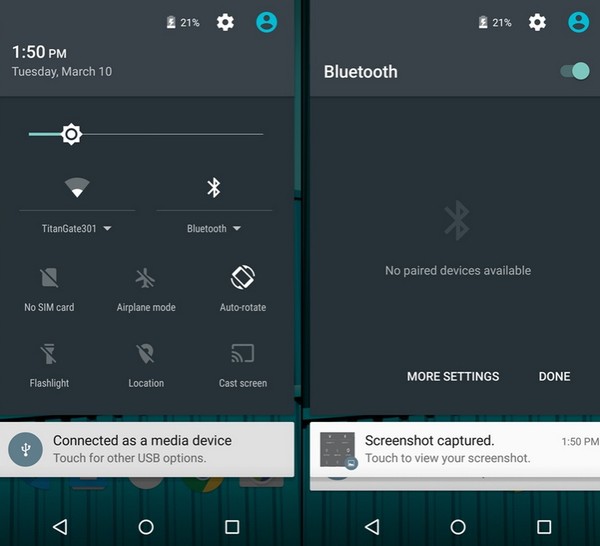
3. Improve Bluetooth switch
As in the previous case, clicking on the text right below the Bluetooth icon will open a special menu with nearby Bluetooth devices right in the notifications. But remember that this new menu will not allow you to search for available devices. In order to do this, you still have to go to the Bluetooth menu in the settings. Thus, to switch between the conjugate bluetooth devices no longer need to leave any application.
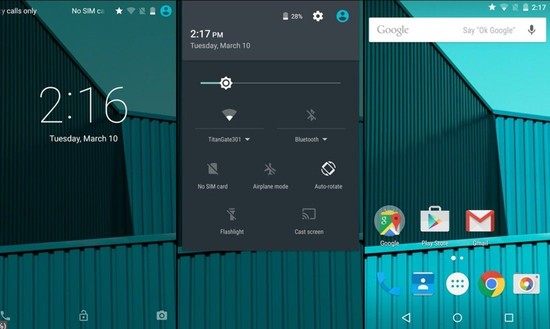
Click to enlarge
4. Improved screen lock
If in the locked mode on Android 5.1, perform a swipe down from the notification line, then you can unlock the phone, going beyond open menu. If, however, to hold up in the notification settings, the phone will be blocked again. This is a subtle change of Android 5.0.x: previously, the user in any case remained in locked mode.

Click to enlarge
5. Hiding the invert / Wi-Fi access point
If you have already tried Android 5.0 Lollipop, then you may have inadvertently added two switches to the quick settings - color inversion and Wi-Fi Hotspot. Unfortunately, after switching on there is no option to remove them from the quick settings. But Android 5.1 allows you to remove unnecessary items. As soon as they appear, simply press and hold the corresponding switch, then click on "Hide".

6. More convenient screen fastening
The docking screen, which debuted with Lollipop, came in handy, but its unfinished view scared users. In the new version of the OS, the function operates according to the same principles, but offers a more convenient interface.

7. Improved heads-up notifications
After receiving notifications and their ascent at the top of the display, you can now swipe to hide them, but keep the notification itself in the top row.

8. No breaks until the next alarm.
This is a handy addition to the “Prioroty” mode: if you set the alarm, you will be able to turn on the priority mode until the signal disappears. In other words, idle mode and notifications are now in proper order.
9. Device Protection
About this innovation, we wrote above. Lost or stolen devices will now remain locked until the original user enters account Google. The lock remains active even after resetting to factory settings. It is good to hear. New feature Security will initially only be available on Nexus 6 and 9, but Google plans to extend support to a much larger number of Android 5.1 devices.
And the last mentioned innovation has already touched the main function of the phone. Owners of compatible phones will be able to use crystal clear voice callsif their mobile operator supports this feature. Nexus 6 on T-Mobile or its upcoming version for Verizon, for example, among these compatible devices.
Consider a few effective ways increase the volume on Android through engineering menu.
The creators of this operating system have provided the presence of several modes of sound signals.
The volume of each of the signals depends on the connected device, the running task, or the situation of using the phone.
For example, the sound on the smartphone can be muffled, and when you turn on the headset, the volume can increase dramatically.
If you encounter similar inaccuracies in the operation of sound, We advise you to conduct an engineering volume adjustment. This way implies a more complicated setup process, however, even beginners can master it. the main thing - carry out all the steps of the instruction in order.
Standard Setup Method
The volume of the sound of an Android smartphone is regulated by the system for each task separately:
- Incoming calls;
- Voice recording or conversation with another subscriber;
- System sounds;
- Play media files.
Note! For all gadgets with MTK processor of any generation, a single code is valid - *#*#54298#*#* or the combination * # * # 3646633 # * # *.
Enter the menu using third-party software
If you did not manage to enter the engineering menu using the first method or you simply do not have our code for your gadget, use a third-party utility - a program that automatically connects to the engineering menu and allows you to change the configuration of the smartphone through its interface.
One of the most reliable and popular utilities for working with the secret menu is MTK Engineering Mode. It can be downloaded and installed on your gadget for free.

Also, you can choose any other program for working with engineering settings by entering the phrase “Engineering Mode” in the search field in the store.
For start secret menu just open the app. No additional codes or other information need to be entered.
Implications of customization
Problems with sound can occur absolutely on any phone or tablet.
The reasons for their occurrence and the nature of the malfunction may be expressed in different ways, but the methods of troubleshooting are always the same.
The software shell implies an identical configuration of a sound card for smartphones from different manufacturers.
Differences can occur only in different versions firmware, or if your device is running a custom OS manufacturer based on Android (for example, Flyme OS).
Each user should understand that the engineering menu setting does not help to sound at the same level as expensive devices.
At the same time, changing the configuration of the menu allows you to eliminate all interruptions in the sound and eliminate the noise that has appeared.
Setting all the parameters of the engineering menu "to the maximum" does not guarantee the best sound quality. On the contrary, such a setting can significantly damage the gadget and cause hardware problems with the speakers. This is due to the fact that the sound starts to play at frequencies that the speaker cannot use.
As a result of improper settings, there may be noise when playing or recording sound, as well as wheezing, hum.
Volume up
After successfully launching the engineering menu on your gadget, you can proceed to increase the volume of the phone. Follow all instructions strictly in accordance with each step of the article.
Otherwise, the playback quality may deteriorate.
Immediately after opening the menu, familiarize yourself with its interface.
The main window has several tabs, each of which is responsible for global settings (testing of hardware components, working with a software shell, and so on).
D to move between tabs, use the swipe right-left.
Follow the instructions:
1 Go to the clutch "Hardware Testing";
2 Click on the item "Audio";

3 In the window that opens, a list of all modes that are available for setting on your device will be displayed. - normal mode, conversational and aural speaker, notifications, and more. Click on the desired parameter (the value of each option is indicated in the next section of the article);
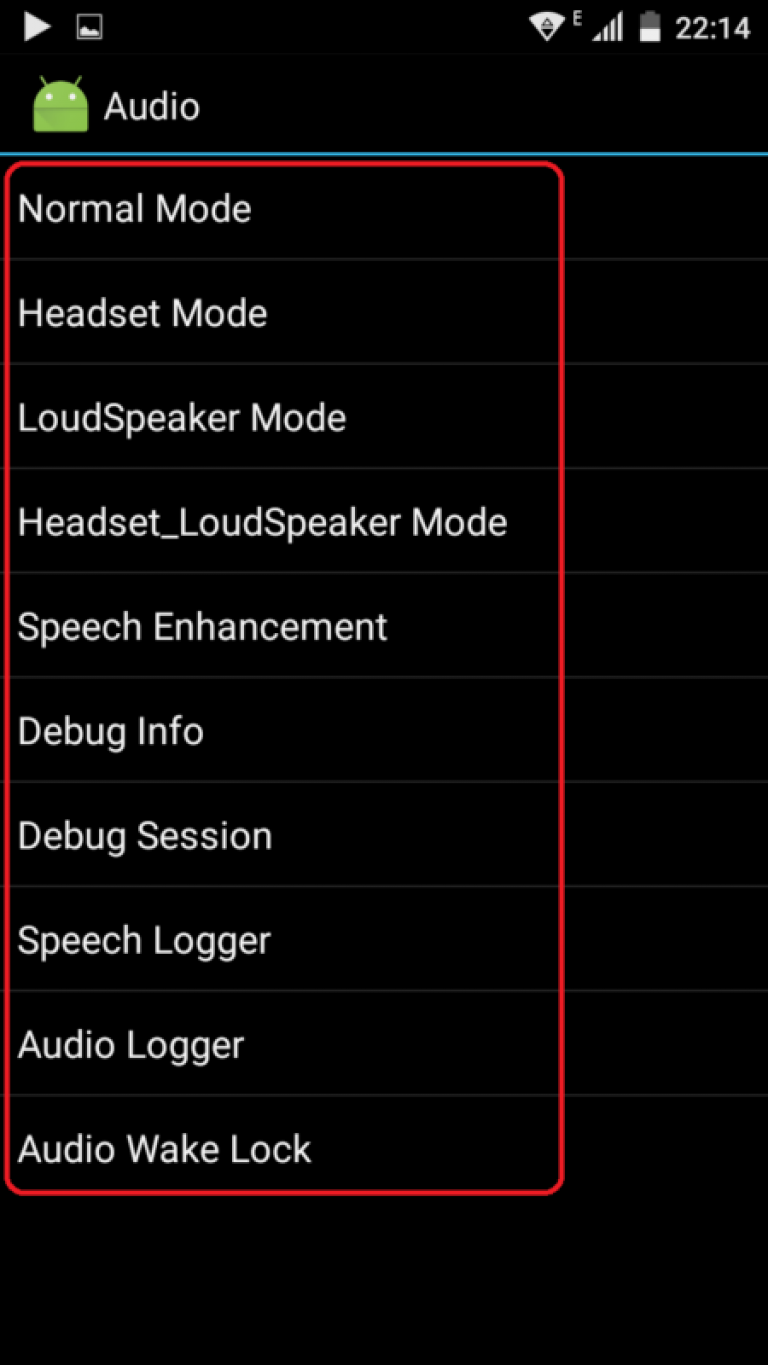
4 In the window that opens, click on the field. Type and in the list that appears, select the desired field ( Sip - for setting up cellular communication and internet connection, Mic - to determine the sensitivity of the microphone, Sph - to set the speaker settings, Sph 2 - the second speaker, Sid - reflection of sound or echo, it is better not to change this field, Media - volume mode of media files, Ring - the volume of the call and notification, FMR - radio mode;
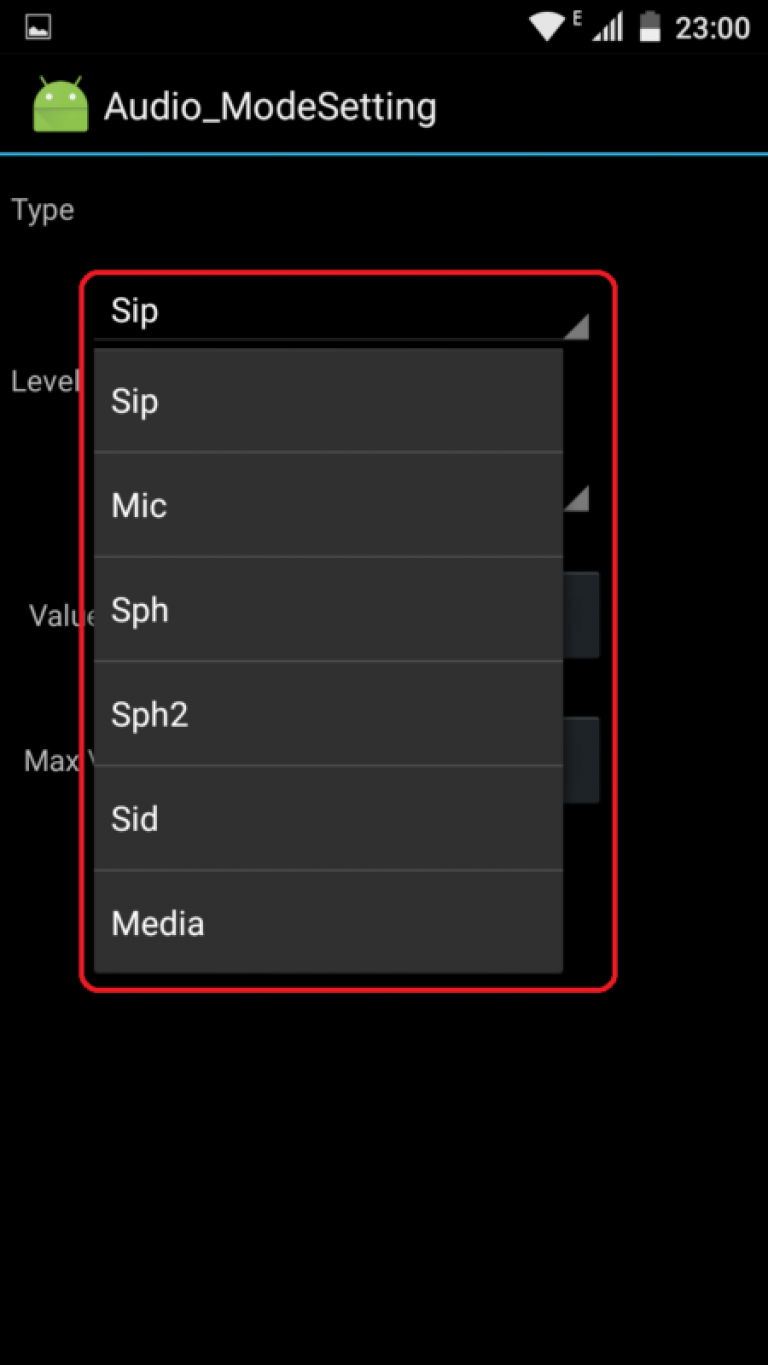
5 In the next field Level set the volume level (we advise you to click to the zero level first and check the sound that has changed - so go to the most appropriate level of playback);
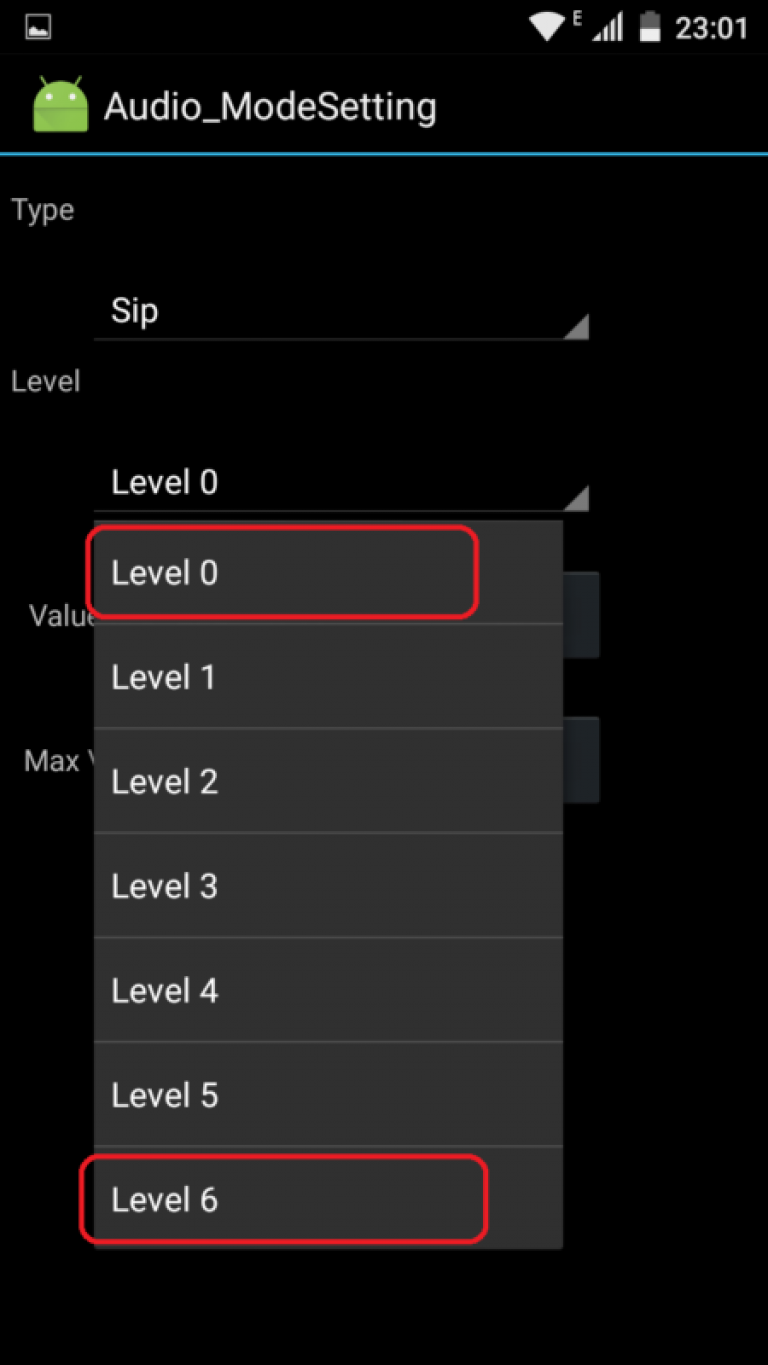
6 The next step is to adjust the value for the selected volume level. Enter it in the field Value is (default volume). The value range can be any number from 0 to 255. We advise you to set the averaged value;
7 In the same way, enter a number in the field. Max Vol . - maximum volume. To save the settings, press the keys « Set » ;

8 Put down Value is and Max Vol for other volume levels. Remember each level is your one click on the volume up / down key. It is important that the transition changes sound as smooth as possible.

All other tabs of the engineering menu are configured the same way and have the same parameters.
Last time you and I figured out like on a smartphone. Now let's talk about other settings: sound and display .
These settings are located in paragraph Applications - Settings . Let's sort them in order.
Sound settings on the smartphone
Located in the settings in paragraph Sound . You can put a profile there Soundless . When you need to turn off the sound, put a tick against this option. And then at the top of the status bar you will see the crossed-out microphone icon.
In addition, you can adjust the vibration. Setting options: always, not always, in mode Soundless and not in mode Soundless .
You can also adjust the following sound settings on your smartphone: incoming call, music and video. system sounds, notifications.
In the sound settings there is also the setting of the ring tone, and the notification tone.
Also there is an item in the settings Feedback : vibration by pressing the keys, and Vibration intensity .
You can also connect the sound when dialing a number, and the sound when you tap the screen.
Display settings on the smartphone
AT android smartphones You can also change the display settings. To do this, go to Settings and choose an item Display .
The maximum number of display settings is in paragraph. Screen . There you can choose a font style, or download a new one. Also there is a large selection of wallpapers - from the gallery of finished images, and interactive wallpaper.
You can also customize the wallpaper through the main screen by clicking on the display touch button below, and selecting Display .
In the settings screen in paragraph Applications - Settings - Display - Screen You can also choose a lock screen, and the location of the clock.
You can also customize Screen brightness .
Screen mode - this setting offers three modes: dynamic, standard and style. These options differ between the clarity and contrast of the images.
Auto-rotate screen - Enabled option allows you to automatically switch the screen orientation when the phone rotates.
Animation - These are smooth transitions when switching between windows. There are three options for using animation: never. sometimes and always.
Screen timeout - setting the delay before auto shut off screen when no action is taken on the smartphone.
Touch Button Backlight Time - Similarly, you can set the time when the buttons are lit, if they do nothing with the smartphone.
 Auto-adjust screen brightness
- analysis of outdoor lighting is performed, and the screen brightness is adjusted accordingly. The screen in the dark will not glow as bright as in daylight. Saves energy.
Auto-adjust screen brightness
- analysis of outdoor lighting is performed, and the screen brightness is adjusted accordingly. The screen in the dark will not glow as bright as in daylight. Saves energy.
Horizontal calibration - using this item you can determine the location of the smartphone relative to the horizontal.
Calibration Hydrosensor - allows you to determine the speed of rotation of the smartphone relative to the horizon.
The last two options are used for games made on the basis of turning the smartphone in space.
You can get more detailed information in the "All Courses" and "Usefulness" sections, which can be accessed through the top menu of the site. In these sections, articles are grouped by subject in blocks containing the most detailed (as far as possible) information on various topics.
You can also subscribe to the blog, and learn about all the new articles.
It does not take much time. Just click the link below:
